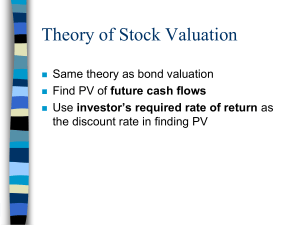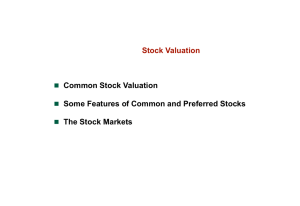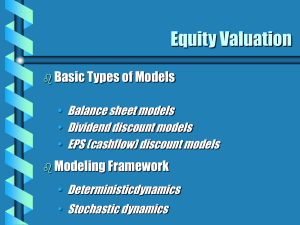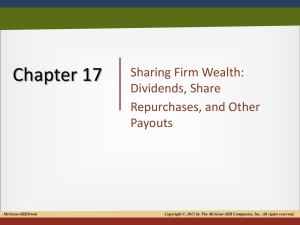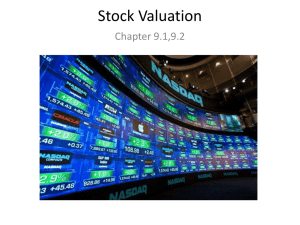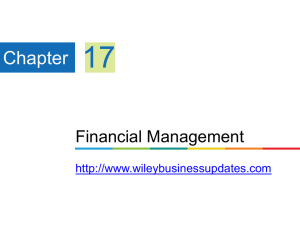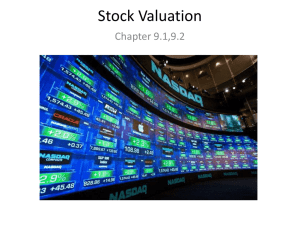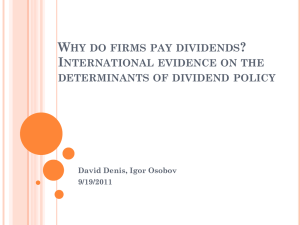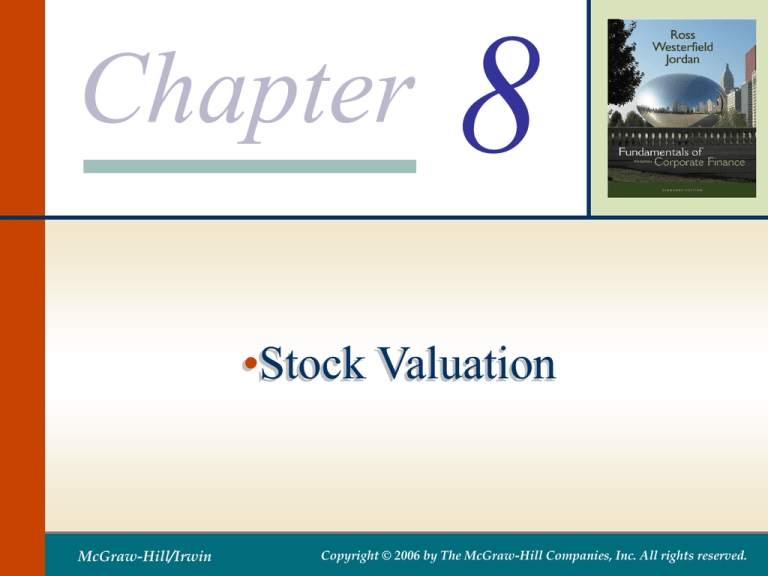
Chapter
8
•Stock Valuation
McGraw-Hill/Irwin
Copyright © 2006 by The McGraw-Hill Companies, Inc. All rights reserved.
Key Concepts and Skills
• Understand how stock prices depend on
future dividends and dividend growth
• Be able to compute stock prices using the
dividend growth model
• Understand how corporate directors are
elected
• Understand how stock markets work
• Understand how stock prices are quoted
8-1
Chapter Outline
• Common Stock Valuation
• Some Features of Common and Preferred
Stocks
• The Stock Markets
8-2
Cash Flows for Stockholders
• If you buy a share of stock, you can
receive cash in two ways
• The company pays dividends
• You sell your shares, either to another investor
in the market or back to the company
• As with bonds, the price of the stock is the
present value of these expected cash flows
8-3
One Period Example
• Suppose you are thinking of purchasing
the stock of Moore Oil, Inc. and you expect
it to pay a $2 dividend in one year and you
believe that you can sell the stock for $14
at that time. If you require a return of 20%
on investments of this risk, what is the
maximum you would be willing to pay?
• Compute the PV of the expected cash flows
• Price = (14 + 2) / (1.2) = $13.33
• Or FV = 16; I/Y = 20; N = 1; CPT PV = -13.33
8-4
Two Period Example
• Now what if you decide to hold the stock
for two years? In addition to the dividend in
one year, you expect a dividend of $2.10 in
two years and a stock price of $14.70 at
the end of year 2. Now how much would
you be willing to pay?
• PV = 2 / (1.2) + (2.10 + 14.70) / (1.2)2 = 13.33
8-5
Three Period Example
• Finally, what if you decide to hold the stock for
three years? In addition to the dividends at the
end of years 1 and 2, you expect to receive a
dividend of $2.205 at the end of year 3 and the
stock price is expected to be $15.435. Now how
much would you be willing to pay?
• PV = 2 / 1.2 + 2.10 / (1.2)2 + (2.205 + 15.435) /
(1.2)3 = 13.33
8-6
Developing The Model
• You could continue to push back when you
would sell the stock
• You would find that the price of the stock is
really just the present value of all expected
future dividends
• So, how can we estimate all future
dividend payments?
8-7
Estimating Dividends: Special
Cases
• Constant dividend
• The firm will pay a constant dividend forever
• This is like preferred stock
• The price is computed using the perpetuity
formula
• Constant dividend growth
• The firm will increase the dividend by a constant
percent every period
• Supernormal growth
• Dividend growth is not consistent initially, but
settles down to constant growth eventually
8-8
Zero Growth
• If dividends are expected at regular intervals
forever, then this is a perpetuity and the present
value of expected future dividends can be found
using the perpetuity formula
• P0 = D / R
• Suppose stock is expected to pay a $0.50
dividend every quarter and the required return is
10% with quarterly compounding. What is the
price?
• P0 = .50 / (.1 / 4) = $20
8-9
Dividend Growth Model
• Dividends are expected to grow at a
constant percent per period.
• P0 = D1 /(1+R) + D2 /(1+R)2 + D3 /(1+R)3 + …
• P0 = D0(1+g)/(1+R) + D0(1+g)2/(1+R)2 +
D0(1+g)3/(1+R)3 + …
• With a little algebra and some series work,
this reduces to:
P0
D 0 (1 g)
R -g
D1
R -g
8-10
DGM – Example 1
• Suppose Big D, Inc. just paid a dividend of
$.50. It is expected to increase its dividend
by 2% per year. If the market requires a
return of 15% on assets of this risk, how
much should the stock be selling for?
• P0 = .50(1+.02) / (.15 - .02) = $3.92
8-11
DGM – Example 2
• Suppose TB Pirates, Inc. is expected to
pay a $2 dividend in one year. If the
dividend is expected to grow at 5% per
year and the required return is 20%, what
is the price?
• P0 = 2 / (.2 - .05) = $13.33
• Why isn’t the $2 in the numerator multiplied by
(1.05) in this example?
8-12
Stock Price Sensitivity to
Dividend Growth, g
250
D1 = $2; R = 20%
Stock Price
200
150
100
50
0
0
0.05
0.1
0.15
0.2
Growth Rate
8-13
Stock Price Sensitivity to
Required Return, R
250
D1 = $2; g = 5%
Stock Price
200
150
100
50
0
0
0.05
0.1
0.15
0.2
0.25
0.3
Growth Rate
8-14
Example 8.3 Gordon Growth
Company - I
• Gordon Growth Company is expected to
pay a dividend of $4 next period and
dividends are expected to grow at 6% per
year. The required return is 16%.
• What is the current price?
• P0 = 4 / (.16 - .06) = $40
• Remember that we already have the dividend
expected next year, so we don’t multiply the
dividend by 1+g
8-15
Example 8.3 – Gordon Growth
Company - II
• What is the price expected to be in year 4?
• P4 = D4(1 + g) / (R – g) = D5 / (R – g)
• P4 = 4(1+.06)4 / (.16 - .06) = 50.50
• What is the implied return given the
change in price during the four year
period?
• 50.50 = 40(1+return)4; return = 6%
• PV = -40; FV = 50.50; N = 4; CPT I/Y = 6%
• The price grows at the same rate as the
dividends
8-16
Nonconstant Growth Problem
Statement
• Suppose a firm is expected to increase
dividends by 20% in one year and by 15%
in two years. After that dividends will
increase at a rate of 5% per year
indefinitely. If the last dividend was $1 and
the required return is 20%, what is the
price of the stock?
• Remember that we have to find the PV of
all expected future dividends.
8-17
Nonconstant Growth – Example
Solution
• Compute the dividends until growth levels
off
• D1 = 1(1.2) = $1.20
• D2 = 1.20(1.15) = $1.38
• D3 = 1.38(1.05) = $1.449
• Find the expected future price
• P2 = D3 / (R – g) = 1.449 / (.2 - .05) = 9.66
• Find the present value of the expected
future cash flows
• P0 = 1.20 / (1.2) + (1.38 + 9.66) / (1.2)2 = 8.67
8-18
Quick Quiz – Part I
• What is the value of a stock that is
expected to pay a constant dividend of $2
per year if the required return is 15%?
• What if the company starts increasing
dividends by 3% per year, beginning with
the next dividend? The required return
stays at 15%.
8-19
Using the DGM to Find R
• Start with the DGM:
P0
D 0 (1 g)
R -g
rearrange
R
D1
R -g
and solve
D 0 (1 g)
P0
g
for R
D1
g
P0
8-20
Finding the Required Return Example
• Suppose a firm’s stock is selling for
$10.50. They just paid a $1 dividend and
dividends are expected to grow at 5% per
year. What is the required return?
• R = [1(1.05)/10.50] + .05 = 15%
• What is the dividend yield?
• 1(1.05) / 10.50 = 10%
• What is the capital gains yield?
• g =5%
8-21
Table 8.1 - Summary of Stock
Valuation
8-22
Features of Common Stock
•
•
•
•
Voting Rights
Proxy voting
Classes of stock
Other Rights
• Share proportionally in declared dividends
• Share proportionally in remaining assets
during liquidation
• Preemptive right – first shot at new stock issue
to maintain proportional ownership if desired
8-23
Dividend Characteristics
• Dividends are not a liability of the firm until a
dividend has been declared by the Board
• Consequently, a firm cannot go bankrupt for not
declaring dividends
• Dividends and Taxes
• Dividend payments are not considered a business
expense; therefore, they are not tax deductible
• The taxation of dividends received by individuals
depends on the holding period
• Dividends received by corporations have a
minimum 70% exclusion from taxable income
8-24
Features of Preferred Stock
• Dividends
• Stated dividend that must be paid before
dividends can be paid to common
stockholders
• Dividends are not a liability of the firm and
preferred dividends can be deferred
indefinitely
• Most preferred dividends are cumulative – any
missed preferred dividends have to be paid
before common dividends can be paid
• Preferred stock generally does not carry
voting rights
8-25
Stock Market
• Dealers vs. Brokers
• New York Stock Exchange (NYSE)
• Largest stock market in the world
• Members
•
•
•
•
•
Own seats on the exchange
Commission brokers
Specialists
Floor brokers
Floor traders
• Operations
• Floor activity
8-26
NASDAQ
• Not a physical exchange – computerbased quotation system
• Multiple market makers
• Electronic Communications Networks
• Three levels of information
• Level 1 – median quotes, registered
representatives
• Level 2 – view quotes, brokers & dealers
• Level 3 – view and update quotes, dealers
only
• Large portion of technology stocks
8-27
Work the Web Example
• Electronic Communications Networks
provide trading in Nasdaq securities
• INET allows the public to view the “order
book” in real time
• Click on the web surfer and visit The
Island!
8-28
Reading Stock Quotes
• Sample Quote
4.5 57.50 38.60 HarrahEntn HET 1.20 2.3 20 10943 52.03 0.35
• What information is provided in the stock
quote?
• Click on the web surfer to go to Bloomberg
for current stock quotes.
8-29
Quick Quiz – Part II
• You observe a stock price of $18.75. You
expect a dividend growth rate of 5% and
the most recent dividend was $1.50. What
is the required return?
• What are some of the major characteristics
of common stock?
• What are some of the major characteristics
of preferred stock?
8-30
Chapter
8
•End of Chapter
McGraw-Hill/Irwin
Copyright © 2006 by The McGraw-Hill Companies, Inc. All rights reserved.



